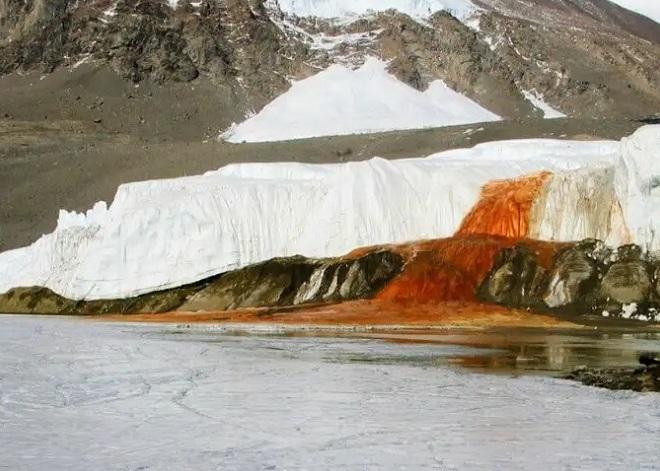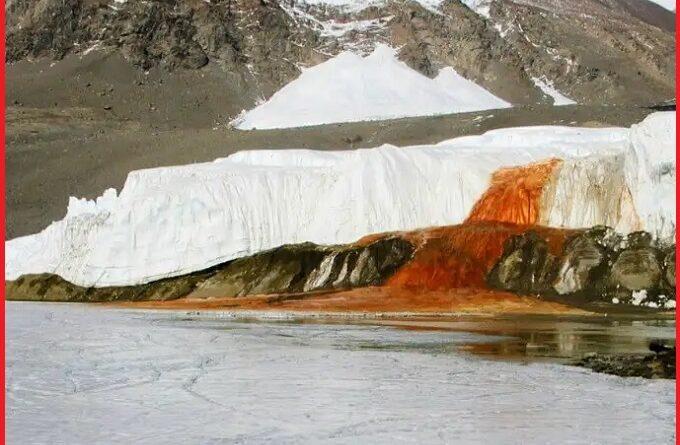The Ultimate Secrets behind ‘Blood waterfall Antarctica’
Blood Waterfall Antarctica
Blood Waterfalls is a natural phenomenon and one of the most strangest places in the world whose water is red in color due to the presence of huge amounts of Iron. It is located in the McMurdo Dry Valleys of Antarctica. It is a blood-red waterfall that flows out of the Taylor Glacier into Lake Bonney. The water in the falls appears to be stained red with blood, hence the name. The red coloring is due to “oxidized iron in brine saltwater, the same process that gives the iron a dark red color when it rusts.” The water that feeds the Waterfalls originates from a subglacial lake that has been isolated from the outside world for more than a million years. The lake is believed to be one of the saltiest and most acidic in the world, with no oxygen or light, making it an extreme environment for life.
When was blood falls discovered-Blood waterfall Antarctica was first discovered in 1911 by the Australian geologist Griffith Taylor, who was part of an expedition to the region. The Waterfalls have been studied extensively by scientists over the years, who are interested in understanding the unique microbial ecosystem that exists in the subglacial lake and how it has adapted to such extreme conditions. Today, Blood Falls is a popular destination for scientific research and tourists who are fascinated by this natural wonder. However, due to its location in a remote and harsh environment, visiting the falls is a challenging and expensive endeavor.

Blood falls glacier
The correct name for the glacier associated with Blood Falls is the Taylor Glacier. The Taylor Glacier is the source of the water that feeds Blood Falls. The Taylor Glacier is an approximately 54-kilometer-long glacier that flows from the East Antarctic Ice Sheet into the McMurdo Dry Valleys. It is notable for its distinctive blue color, which is caused by the ice absorbing almost all of the red light in the visible spectrum, making the ice appear blue.
Antarctica blood falls bacteria-The Taylor Glacier is also of great interest to scientists due to its location and the extreme conditions that exist beneath it. The glacier covers a subglacial lake that has been isolated from the outside world for millions of years, creating a unique ecosystem of microbes that have adapted to the harsh and extreme conditions.
Researchers have drilled into the glacier to study the subglacial lake and its ecosystem, which has been found to contain a diverse range of microorganisms that survive in conditions of high salinity, low oxygen, and extreme cold. The study of the subglacial lake and the Taylor Glacier continues to provide insights into how life can survive in extreme environments and has important implications for astrobiology and the search for life beyond Earth.
How was blood falls formed
Blood waterfall Antarctica was formed through a complex series of geological and environmental processes over millions of years. The water that feeds Blood Falls originates from a subglacial lake that has been sealed off from the outside world for over a million years. The lake is believed to be one of the saltiest and most acidic in the world, and contains high concentrations of iron. As the water from the subglacial lake flows through the Taylor Glacier towards Lake Bonney, it interacts with the air and oxygen, causing the iron in the water to oxidize and turn red, giving the water its distinctive blood-like appearance. The water flows out of a fissure in the glacier and cascades down a steep slope, creating the striking Blood waterfall Antarctica.
Mystery of Blood falls
Blood waterfall Antarctica is a unique and striking natural wonder, it has fascinated scientists and visitors for over a century. Despite extensive research, there are still many mysteries surrounding the formation and behavior of Blood Falls. One of the biggest mysteries is how the subglacial lake that feeds Blood Falls has remained isolated for millions of years. Scientists believe that the lake may be connected to other subglacial lakes or may have a hydrological system that allows water to flow in and out of the lake without disrupting its isolation. However, the exact mechanisms that maintain this isolation are still not fully understood.
Another mystery is the source of the iron in the water that gives Blood waterfall Antarctica its distinctive red color. While scientists have determined that the water is high in iron, it is still unclear where this iron comes from and how it interacts with the water to produce the red color. Some researchers have suggested that the iron may be derived from the bedrock beneath the glacier, while others believe that it may be generated by microbial activity within the subglacial lake.

Despite these mysteries, scientists continue to study Blood waterfall Antarctica and the subglacial lake to gain new insights into the unique microbial ecosystem that exists in this extreme environment, and to learn more about the processes that drive the formation and behavior of this remarkable natural wonder.
How to Reach Blood waterfall Antarctica
Reaching Blood waterfall Antarctica can be a challenging and potentially dangerous undertaking due to its remote location in the McMurdo Dry Valleys of Antarctica and the extreme environmental conditions in the region. The most common way to reach Blood Falls is by joining an expedition organized by a tour company or research organization. These expeditions typically depart from cities such as Christchurch, New Zealand or Punta Arenas, Chile and travel by plane to McMurdo Station, a U.S. research facility located near the McMurdo Dry Valleys.
Once at McMurdo Station, visitors must obtain the necessary permits and undergo safety training before they are allowed to travel into the Dry Valleys. The journey to Blood Falls typically involves a combination of travel by snowmobile or helicopter, and can take several hours to complete. Overall, visiting Blood Falls is a once-in-a-lifetime experience that requires careful planning and preparation, but offers the opportunity to witness one of the most unique and striking natural wonders on Earth.



